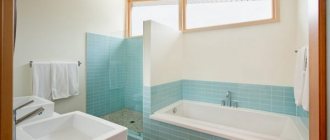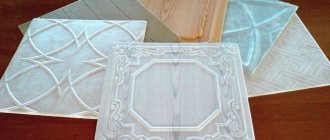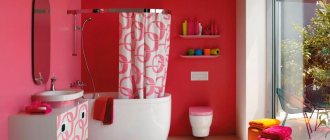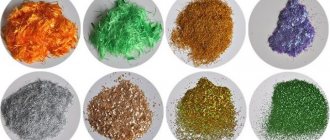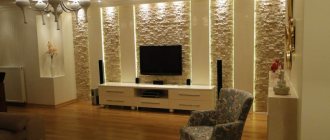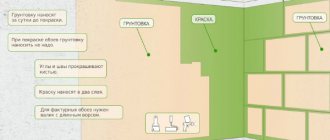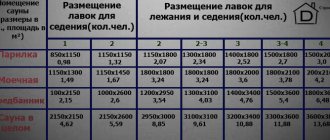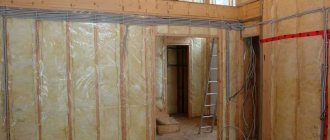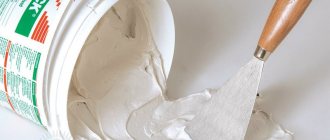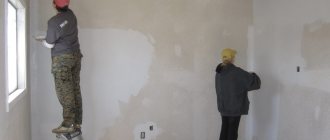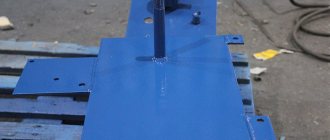Finishing ceilings in rooms, including in the bathroom, can be done in two ways. One of the dry methods is suspended ceilings of all types, and the other, the so-called wet, is plastering or putty with subsequent finishing. Most types of suspended ceilings, with the exception of suspended ceilings, are very easy to do yourself and still get a perfectly flat surface. The most significant drawback is a significant reduction in the height of the room, especially if built-in lights are used.
A putty ceiling does not change the height of the room, is less expensive financially, but requires some experience in such work. In the absence of the proper skills, it is difficult to obtain a flat surface the first time, but the technology itself allows for the correction of defects either by sanding or reapplying a layer of putty. At the same time, the small ceiling area allows it to be used as a “training ground” for developing the necessary skills.
What properties should bathroom putty have?
First of all, let's figure out what putty is? This is the finishing layer that is applied before final finishing to create a perfectly flat and smooth surface. The main purpose of applying putty is to eliminate minor defects and cracks.
More serious unevenness must first be corrected using plaster or drywall.
Regardless of what you use to finish the bathroom in the future, the leveling layer should have the following characteristics:
- Moisture resistance. The bathroom is a room with high humidity. The coating should not deteriorate or peel off under the influence of moisture, even over time.
- Durability. The service life of such a coating without loss of quality should be long.
- Resistant to temperature changes. Temperature changes should not lead to deformation of the putty layer, otherwise the lining will not stick to it.
These are the main criteria by which you need to choose a composition. All other characteristics depend on your individual needs and further cladding.
Choosing a manufacturer
When buying a mixture for plastering a bathroom for painting, it is better to avoid unnecessary savings. External indicators and reliability of the coating will depend on its quality. There are several brands that have earned the trust of consumers. Rotband and Vetonit can be considered the most famous. Dry, ready-made formulations can be found on sale. Subject to all conditions, proper preparation and application, the quality of work will delight you for a long time. Unlike plaster, the cost of the substance to carry out putty will be insignificant. You can find very small amounts of the composition.
Among the most popular types are:
- Vetonit VH is used for wet rooms, developed on the basis of cement. A layer of two millimeters. It will be dry in just a couple of days;
- Vetonit KR+. Polymer based mixture. Dry within 24 hours. Layer up to five millimeters;
- Vetonit KR. Glue-based substance. Dries in a day. Gives a layer of up to three millimeters.
Types of putty based on raw materials
Depending on the type of main component and purpose, bathroom putty for painting comes in the following types.
Cement
One of the main advantages of this type of mixture is its high resistance to moisture. Therefore they are recommended for use in the bathroom. The cost of such material is within reasonable limits, and the characteristics are quite high.
Important! When exposed to moisture, the putty becomes even stronger. But this composition dries slowly and shrinks.
Polymer
At the moment, these are the most advanced developments, which, of course, affects the price. The surface is very even and smooth. This putty is flexible and easy to work with, and does not shrink.
There are 2 types of polymer-based putty:
- Acrylic - has a high level of plasticization, so it can fill small irregularities and defects. The composition is odorless and has a high degree of adhesion to surfaces made of wood or concrete.
- Latex composition - allows you to get a mirror surface that is not prone to cracking and shedding.
Plaster
Gypsum mixtures are not suitable for the bathroom, as they are not able to resist the concentration of hot steam, not to mention possible leaks from above.
Oil-adhesive
One of the first putty powders, which is considered obsolete. How to beautifully paint walls with wallpaper for painting? The quality of work with such a composition is very low.
Therefore, it is mainly used for utility rooms that do not require high-quality finishing.
Requirements for putty materials
In addition to such parameters, you need to take into account the requirements that the putty for the bathroom must meet. The most important parameters are:
- The characteristics of such materials should not change during operation at high humidity. The ideal situation is when a wet environment strengthens the surface with a thin layer of putty.
- Such compositions should be as durable as possible. In this case, the optimal service life can be considered to be at least 20 years.
- After polymerization, the applied layer should not be subject to thermal deformation.
Types of putties by purpose
What bathroom putty is suitable for painting? We are looking for special markings on the packaging that the mixture is suitable for use in a bathroom. Next, we select one of the options, since depending on the purpose, putties are divided into:
- finishing putty, which is most often sold in ready-made form and is used for final finishing of walls;
- leveling putty, which is used for the initial leveling of walls or ceilings;
- A universal putty composition allows for both leveling and final finishing.
Important! Before applying any mixture, regardless of its composition, you need to coat the walls with a primer, which ensures adhesion of the surface to the material. In addition, it performs an antiseptic function.
Special approach
Putty consists of a whole mixture of various components, in which coarse-grained particles play the main role. They allow the solution to more thoroughly level the surface of the wall or ceiling in the shower room. After applying the putty, it is best to wait for it to dry completely, and then wipe and rub it thoroughly. Otherwise, application to a damp and unprepared base will result in a lack of high-quality coating. Various flaws, irregularities, and roughness will be visible. You can glue waterproof wallpaper to finished walls in the bathroom, but then you will need putty made from smaller particles.
Applying putty
In order to properly apply putty to the wall or ceiling in the bathroom, you need to select the right tool. For example, a wide spatula is best for comfortable work. In some respects, it looks more like a spatula with a thin metal base. When applying putty with this device, you can feel all the bends and unevenness of the surface. This is very helpful when working and also makes it much easier.
The putty should be applied in a layer of no more than 2–3 mm, however, this indicator directly depends on the degree of unevenness of the ceiling or wall. In order for the mixture to dry, you need to wait a certain period of time. The most reliable drying method is natural. Artificial methods in the form of various heat sources, convectors or ventilation systems will lead to premature drying, which will result in the appearance of cracks.
Mixture release form
Depending on the readiness of the material for use, there are two types of putties:
- Dry mixture - water is required for dilution. Such mixtures harden quickly, so they need to be prepared in small portions.
- The finished composition is more expensive, but at the same time more convenient to apply. The shelf life of this composition is quite long; over time, it does not lose its quality characteristics.
Important! If you have not yet had experience in repair work, but in this case you want to do everything yourself, choose ready-made mixtures. This way there will be less risk that you will do something wrong.
Sealing cracks and joints of slabs
Any cracks and joints must be sealed with cement mortar before starting puttying. Otherwise, a large layer thickness in such places will lead to uneven drying of the material and to repeated cracking. Similar work is carried out using reinforcing tape. It is sold in rolls of various widths. The tape should cover the crack by 1.5–2 cm on each side. For winding cracks, the tape must be cut into pieces and applied so that the individual pieces overlap each other.
First, the crack or joint is sealed with mortar, and then the tape is pressed into it with a spatula. For work it is necessary to use low-drying mixtures with high strength. Mixtures for sealing joints of plasterboard boards have proven themselves well. Some craftsmen get good results when using ordinary putty, mixed not with pure water, but with the addition of 30% primer.
The resulting mixture must first be tested on a trial plot. Typically, such solutions set very quickly, so they must be prepared in small quantities and try to apply without flaws, since it will be difficult to remove deposits of dried plaster.
Plastering and painting the bathroom
If you have decided how to putty the walls in the bathroom before painting, you can’t just apply the compound and level the walls. First the surface needs to be prepared.
Surface preparation
In order for the coating to hold firmly and not deform over time, the surface must be cleaned and primed. For this:
- First you need to remove the old coating layer from the surface. If there are irregularities, they are knocked down with an ax or cut off with a grinder. After this, the walls are cleaned with a solvent to remove grease stains and with a damp cloth to remove dust and dirt.
- If the surface is severely damaged, then it must be treated with cement plaster, which will fill all large cracks and defects.
- Then you need to treat the walls with an antiseptic to prevent fungus from appearing.
Important! If the surface is wet, it must first be dried. If there are traces of mold or mildew, they should be cleaned with a wire brush and burned with a blowtorch.
- Now the walls can be treated with a primer, which will fill all the pores and microcracks, strengthen the surface and ensure its adhesion to the subsequent layer of putty.
At this point, the preparatory stage can be considered complete; all that remains is to wait until the primer layer dries.
Work before painting
In order to carry out finishing work, you either need to involve professionals or try to do everything yourself. It is necessary to take into account a large number of nuances and pitfalls. Take into account the cost, quality of the material, calculate the area and condition of the surface being treated, the number of corners, the depth of flaws, and much more.
Removing excess putty
Recommendations:
- You should inspect the walls or ceiling before painting for the presence of microorganisms, rot or mold.
- Mandatory dismantling of outdated coating. Special mixtures that are used according to the instructions will help here. In addition, you can use sandpaper, a scraper or even a grinder. Although the most effective method is a grinding machine with a diamond tip.
Sanding the wall - If defects are identified, they must be eliminated. Protrusions or sharp irregularities can be removed well with a plane, however, a sharp spatula will also work. The cracks are first widened and then cleaned.
- Already prepared recesses must be thoroughly rubbed using a medium-sized spatula. The material is applied in a sweeping, crosswise manner, without pressing unnecessarily.
- If the putty is made from a dry mixture, then it is prepared before application.
- When using the mixture in the shower, you should select a moisture-resistant material. A solution based on latex or acrylic is suitable for this.
- The mixture is applied overlapping in a layer of several millimeters with medium pressure. This allows you to create a smooth surface.
- During drying, you should rid the bathroom of drafts, as well as exposure to ultraviolet radiation. Typically the solution dries in 14–18 hours.
- The hardened surface must be freed from abrasive components.
- It is best to apply the paint in several layers and add antibacterial additives to it.
How to level a ceiling using suspended structures?
The installation of suspended ceilings includes leveling with plasterboard sheets according to the previous method, as well as additionally constructing plasterboard structures in accordance with the design project.
The metal profile frame follows the geometry of the ceiling being created and is usually created in several levels. The frame of the first level is first covered with sheets of plasterboard, then gradually all subsequent ones. Holes for lamps are cut in the required places. Each of the ceiling levels is puttied and rubbed after drying for one to two days.
Along the perimeter of the second and subsequent levels, a board is formed from strips of plasterboard of the required width, behind which wiring, lampshades and night lighting are hidden. Along the perimeter of the room, the joints of the walls and ceiling are decorated with baguette. The last step is to paint the ceiling surfaces in the desired colors.
Advantages of this method of ceiling leveling:
- high decorativeness and aesthetics,
- the ability to create an exclusive ceiling and implement any design idea,
- relatively low cost when creating a ceiling with your own hands,
- the ability to get a finished ceiling in a relatively short time.
The disadvantage of this method is a significant underestimation of the ceiling level by the thickness of the entire ceiling structure.
Puttying the ceiling with your own hands - practical tips and tricks
Before starting work, prepare your tools.
You will need:
- Roller for applying primer.
- Spatulas (it is better to choose different sizes).
- Grater or trowel for grouting
- Mixer attachment for drill.
- Container for diluting the solution.
The last two points apply to cases when dry mixture is purchased.
Additionally, you may need sandpaper and reinforcing mesh. Think about a way to reach the ceiling. Construction sawhorses, a table or a stepladder will do, but it is more difficult to perform such actions on it.
Follow simple recommendations while working. When preparing the mixture, follow the instructions on the packaging. Do not change the amount of liquid to which the dry ingredients are added. Do not add water to an already diluted mixture.
Try to keep the air temperature in the room between +5o and +30o during work. Maintain humidity between 50–80%. Avoid direct sunlight on the ceiling; use artificial lighting.
It is better to use the same brand of primer and putty. Wear safety glasses and a respirator, especially while grouting.
Brief summary
Cement moisture-resistant putty for the bathroom is not the only material that can be used to level walls. Gypsum mixtures can also be used for puttying.
Gypsum-based building mixtures.
In this case, two conditions must be met:
- The final coating of the walls must be waterproof . I provided a list of possible solutions a few paragraphs above;
- The room must be equipped with effective exhaust ventilation . With constant dampness, any mineral-based material will inevitably be affected by fungus.
Low ventilation performance will quickly lead to the appearance of fungus.
In a typical city apartment, for normal ventilation operation, it is enough to install an exhaust hood in the ventilation duct. You should not connect the fan in parallel with the lighting: the bathroom needs ventilation around the clock, but it is used for its intended purpose only one or two hours a day.
Exhaust hood in the bathroom ventilation duct.
To fill minor defects in walls and ceilings, you can use façade acrylic putty. After setting, it tolerates short-term contact with water even without protective painting.
Facade acrylic putty is sold completely ready for use.
On thematic forums you can come across an interesting question: who coated a metal bathtub with noise-reducing putty? I appreciated the mindset of its author, who was inclined to look for non-standard solutions; however, it is much easier to foam the bottom of the bathtub or stick thick microporous rubber on it.
Polyurethane foam applied to the bottom will turn a noisy bathtub into a quiet one.
In order not to be unfounded, I will tell you how and with what I finished the combined bathroom when building the attic of my own house.
The frame is a galvanized profile 50 mm thick (guide and rack).
The wall frame is assembled from galvanized profile.
Sheathing - wall plasterboard. Due to a small error in the calculations, there was not enough moisture-resistant plasterboard, so part of the wall and ceiling cladding was made of ordinary, white plasterboard.
From left to right: regular, moisture-resistant and fire-resistant gypsum plasterboard.
Puttying
How to putty plasterboard in the bathroom along the seams and fastener heads? After a brief reflection, I boldly used gypsum mixtures - HP Start to fill the joints and ABS Saten to level the surface.
Finishing gypsum putty ABS Saten.
I really liked ABS putty because of its long (at least 45 minutes) lifespan after mixing and the fact that it almost never clumps when mixed, even if it does not have time to be completely saturated with water.
The putty for painting for the bathroom was sanded using an oscillating sander and mesh No. 80 and No. 120. The first was used for rough grinding, the second for final smoothing of the surface. After sanding, the walls were vacuumed to remove fine plaster dust and primed with acrylic primer.
For small amounts of sanding, you can get by with a hand grater.
I already wrote about which paint to choose. My choice was the notorious “Rezel+”. Due to the small area of the walls and the abundance of corners, I painted with a brush; In total, I had to apply 4 layers of paint, since with less, the coloring remained uneven. The drying time of one layer did not exceed 60 minutes.
Wonderful paint made in Sevastopol.
If you are tinting the paint, mix it with pigment with a reserve. The instructions are due to the fact that sooner or later the walls will require minor repairs; It is basically impossible to get exactly the same shade again when mixing with your own hands.
When tinting by hand, mix the paint with reserve for future repairs.
A tiled splashback was glued to the wall above the bathtub. The tiles were glued in a somewhat unusual way - with silicone sealant applied in spots. It was also used to fill seams.
The finish is durable and completely waterproof.
The apron tiles above the bathtub are glued with silicone sealant.
Ventilation
A duct fan with a capacity of 105 m3/hour is installed in the exhaust grille of the ventilation duct. Its power supply circuit is dimmable. The dimmer allows you to choose between ventilation performance and silence.
Next to the switch is a dimmer that controls the speed of the exhaust fan.
Operation report
Almost three years have passed since the finishing work was completed, and the interior of the room has retained its impeccable appearance and has no visible signs of damage to the finish.
The photo shows a wall finished with gypsum putty in the bathroom of my attic.
From the article you learned that there are no restrictions on the type of binder for putties and plasters used in the bathroom. With the right choice of finishing, you can safely use building mixtures intended for dry rooms. You can learn more about finishing bathrooms from the video in this article.
